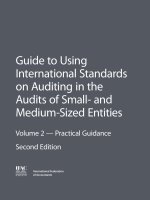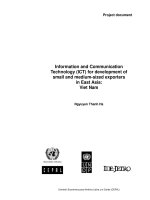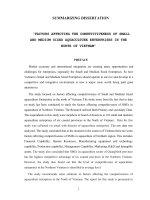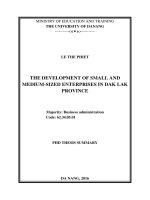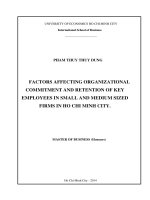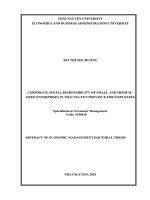factors affecting the competitiveness of small and medium sized aquiculture enterprises in the north of vietnam
Bạn đang xem bản rút gọn của tài liệu. Xem và tải ngay bản đầy đủ của tài liệu tại đây (1.02 MB, 117 trang )
i
Thai nguyen University Southern luzon STATE University
Socialist Republic of Vietnam Republic of Philippine
s
PHAN THỊ MAI HƯƠNG
(English Name: Diana)
“FACTORS AFFECTING THE
COMPETITIVENESS OF SMALL AND MEDIUM
SIZED AQUACULTURE ENTERPRISES IN THE
NORTH OF VIETNAM”
DOCTORAL THESIS
Thai Nguyên 2013
ii
Acknowledgments
I would like to express our most sincere thanks to the Management Board of the
Southern Luzon State University, Thai Nguyen University,, the teacher of the school has
helped me facilitate the learning process throughout.
I would like to express sincere gratitude and profound Professor. Dr. Cecilia N.
Gascon enthusiastic teacher who have dedicated guidance, encouragement, spend time and
exchange orientation for me during this research.
I would like to express my sincere thanks to the board of Directors of Aquaculture
enterprises In HaiPhong, QuangNinh, NamDinh, ThaiBinh, NinhBinh, ThanhHoa
Province has helped me research material, through a questionnaire survey.
I sincerely thank the Board of the University of Labor and Social affair (ULSA),
colleagues in ULSA, classmates DBA1 facilitated enthusiastic help and share my
experience to help complete the thesis.
Finally, I would like to send the gift to the heart of my family has passed enthusiasm
and encouragement to complete my thesis.
iii
DEED OF DECLARATION
I, Phan Thi Mai Huong (English name: Diana), hereby submit my thesis for oral
examination, entitled “FACTORS AFFECTING THE COMPETITIVENESS OF
SMALL AND MEDIUM SIZED AQUACULTURE ENTERPRISES IN THE NORTH
OF VIETNAM” truthfully declare that the said paper is a product of my original research
investigation.
Signed this …………………… 2013 at Thai Nguyen University
Phan Thi Mai Huong
DBA Candidate
iv
Abstract
The study was conducted to analyze the factors affecting competitiveness of SMEs in
aquaculture of Northern Vietnam. The research utilized both primary and secondary data.
The respondents in this study were the members of board of directors of 122 small and
medium aquaculture enterprises of six coastal provinces in the North of Vietnam. Data
for this study was collected via email with director of aquaculture enterprises. The study
adapted from David Aker’s model (2007) for analyzing the factors impacting
competitiveness of aquaculture enterprises in 6 coastal provinces of Northern Vietnam.
Eight criteria that this dissertation identifies as most important internal factors
accounting for enterprises’ competitiveness include: finance capability, management
capability, intangible assets, manufacturing equipment, marketing, production capability,
human resource and R&D.
The dissertation identified the indicator of competitiveness of small and medium sized
aquaculture enterprises in Vietnam nowadays and in particular evaluated the factors
affecting the competitiveness of small and medium aquaculture enterprises in the North of
Vietnam.
Aquaculture enterprises in Quang Ninh own the highest level of competitiveness with
the score of 4.04 (maximum level is 5). In addition, the dissertation ranked the
competitiveness of Northern Vietnam at the average level with the score of 3.40.
In order to enhance competitiveness, small and medium aquaculture enterprises in
northern areas should focus on implementing a number of measures: (1) improving
production capacity; (2) innovating equipment and technology; (3) building brand; (4)
improving the quality of the labor force in aquaculture sector, (5) pushing up the activities
of product research and development.
v
APPROVAL SHEET
This thesis, entitled “FACTORS AFFECTING THE COMPETITIVENESS OF SMALL
AND MEDIUM SIZED AQUACULTURE ENTERPRISES IN THE NORTH OF VIETNAM
”,
prepared and submitted by Phan Thi Mai Huong in partial fulfillment of the requirements for the
degree of Doctor in Business Administration has been examined and recommended for acceptance
and approval for ORAL EXAMINATION.
Professor. Dr
.
Cecilia N. Gascon
Adviser
Approved by the Committee on Oral Examination with a grade of PASSED on ……. 2013
Dr……………………… ………………… Member
Dr……………………… ………………… Member
Dr……………………… ………………… Member
Dr……………………… ………………… Chairman
Accepted in partial fulfillment of the requirements for the degree of Doctor in Business
Administration.
THAI NGUYEN UNIVERSITY SOUTHERN LUZON STATE UNIVERSITY
Dean Dean
vi
TABLE OF CONTENT
CHAPTER I………………………………………. 1
INTRODUCTION…………………………………… 1
1.
Background of the study 1
2. Statement of the problem 3
3.
Hypothesis 5
4.
Objective of the study 5
5.
Scope and limitations of the study 6
6. Definition of terms 6
CHAPTER II……………………………………… 9
LITERATURE REVIEW…………………………… 9
1.
Conceptual framework 9
1.1.
Concept of competition 9
1.2.
Porter’s 5 forces Model 10
1.3. Analyzing competitors & David Aaker’s model 12
2.
Literature Review 14
CHAPTER III………………………………………. 20
RESEARCH METHODOLOGY………………… 20
1.Research design 20
2. Location of the study 22
3. Population, Sample Size and Sampling technique 22
4. Description of research points 24
5. Research Instrument 24
6. Statistical analysis 25
CHAPTER IV…………………………………… … 27
RESULTS AND DISCUSSION…………………… 27
1. Evaluating the reliability of statistic data 27
2.
Descriptive statistics 31
vii
3. Analysis the factors of the competitiveness of Small and Medium Sized Aquaculture
Enterprises of the six provinces in the North of Vietnam 31
3.1.
Financial capability 32
3.2.
Management Capability 34
3.3.
Intangible assets 36
3.4.
Manufacturing equipment and technology capability 38
3.5.
Marketing 40
3.6.
Production capability 44
3.7.
Human Resources 45
3.8.
R&D 48
4. Comparison of competitiveness between provinces in Northern Vietnam in aquaculture
sector. 49
4.1. Financial capability of six coastal provinces in the North of Vietnam 49
4.2. Management Capability 51
4.3. Intangible assets 52
4.4. Manufacturing equipment and technology capability 53
4.5. Marketing 54
4.6. Production capability 56
4.7. Human resources 57
4.8. Research and Development 58
5. Evaluating the competitiveness level of the aquaculture sector in the north of Vietnam 61
CHAPTER V…………………………………… 86
CONCLUSIONS AND RECOMMENDATIONS 86
1. Conclusions 86
2. Recommendations 86
APPENDIX 1 : SURVEY QUESTIONNAIRE…………………………………………………97
APPENDIX 2: COMPETITIVE ADVANTAGE OF EACH PROVINCE 102
APPENDIX 3: ANOVA ANALYSIS…………… 112
APPENDIX 4: POST HOC TESTS……………… 117
APPENDIX 5: KSF competitor ranking 6 provinces of northern Vietnam in aquaculture
sector…………………………………………… 136
viii
LIST OF TABLES
Table 1: KSF Competition Ranking 13
Table 2: Research Respondents 23
Table 3: Cronback alpha of financial capability 27
Table 4: Cronback alpha of management capability 27
Table 5: Cronback alpha of intangible assets 28
Table 6: Cronback alpha of manufacturing equipment and technology capability 28
Table 7: Cronback alpha of marketing 29
Table 8: Cronback alpha of production capability 29
Table 9: Cronback alpha of human resources 30
Table 10: Cronback alpha of research and development 30
Table 11: Illustration method of calculating group variables via mean value 31
Table 12: Financial Capability Crosstabulation 32
Table 13: Management Capability of aquaculture enterprises in the North of Vietnam 34
Table 14: Number of aquaculture enterprises assessed management capability at high level of six
provinces in the North of VietNam 36
Table 15: Intangible assets Crosstabulation 37
Table 16: Manufacturing equipment and technology capability Crosstabulation 39
Table 17: List of Basa price of six coastal provinces surveyed (per kg) 40
Table 18: Price of prawn of six coastal provinces surveyed (20 units / kg) 41
Table 19: Marketing Crosstabulation 43
Table 20: Production capability Crosstabulation 44
Table 21: Human Resources Crosstabulation 46
Table 22: R&D Crosstabulation 48
Table 23: Post Hoc Tests on financial capability 50
Table 24: Post Hoc Tests on management capability 51
Table 25: Post Hoc Tests on intangible assets 52
Table 26: Post Hoc Tests on Manufacturing equipment and technology capability 54
Table 27: Post Hoc Tests on marketing 55
Table 28: Post Hoc Tests on production capability 56
Table 29: Post Hoc Tests on Human Resources 57
Table 30: Post Hoc Tests on Research and Development 59
LIST OF FIGURES
Figure 1: The Value Chain (Porter 1985) Error! Bookmark not defined.
Figure 2: Maps of Vietnam and its 63 provinces (name of coastal provinces are shown only) 22
Figure 3: Number of companies assessed financial capability of six provinces 32
Figure 4: Number of enterprises having high rate of intangible assets 37
Figure 5: Market share of six province in 2012 in domestic maket 42
Figure 6: Number of aquaculture enterprises is rated human resource in six provinces surveyed at
high rate 47
ix
Abbreviation
ADB Asian development bank
AFTA ASEAN Free-Trade Area
APEC Asia-Pacific Economic Cooperation
ASEAN Association of Southeast Asian Nations
ASEM Asia-Europe Meeting
BAT Vietnam- America Bilateral Trade Agreement
CCI Current competitiveness index
EU European Union
FAO Food and Agriculture Organization
GCI Growth competitiveness index
GDP Gross domestic product
GNP Gross National product
KSF Key success factors
IMF International Monetary Fund
NAIC National Association of Investors Corporation
ROF Rate of fund
ROS Rate of sales
x
AQUACULTU
RE
Sea product export
UN United Nations
VASEP Vietnam Association of Seafood Exporters and Producers
VCCI Vietnam Chamber of Commerce and Industry
WB World Bank
WEF World Economic Forum
0
1
CHAPTER I
INTRODUCTION
1. Background of the study
Market economy and international integration are creating many opportunities and
challenges for enterprises, especially the small and medium sized enterprises. So how
Vietnam’s Small and medium sized enterprises should operate to survive and develop in a
competitive and integrative environment is now a major issue worth being paid great
attention to.
In recent years, the Vietnam's economy in general and aquaculture sector in particular
is in the process of economic integration in the Region and the World. This is also a great
opportunity for aquaculture enterprises in the North of Vietnam. However, aquaculture
enterprises in the North have met the big challenges such as stiff competition.
Opportunities of SMEs:
First, Vietnam is increasingly involved deep integration into the economy of the region
and the world, opportunities for the aquatic products will increasingly be expanded. The
northern aquaculture enterprises will have the huge global market for export and
opportunities to expand the market and attract more foreign investment. They will receive
conditional preferential tariffs when exporting fishery products to the WTO member
countries, especially countries where seafood and capable of penetrating the mass
consumption large, such as the EU, USA, Japan, China This is a great opportunity for
aquaculture enterprises in northern areas could increase exports, to expand the market and
high business efficiency.
Second, in recent years aquaculture enterprises in the North have the opportunity to
acquire the advancement of science and technology in the world in aquaculture, processing
and trading.
Thirdly, this time, aquaculture enterprises in the northern region can more easily raise
their capital. There have been a lot of commercial banks founded with the broader lending
institutions in the Northern region. This is a great opportunity for the exploitation of capital
investment to expand production, processing and trading of regional fisheries.
2
Fourth, the WTO, the commodity market's seafood sector is expanding north, the
conditions for aquaculture enterprises to exploit huge potential market to penetrate with
reasonable rates, service rates cheaper inputs. However, it also means that competition is
increasingly fierce, with the tightening conditions seafood export to foreign countries.
Many aquaculture enterprises are well aware of hygiene and food safety so they have
invested in new construction or further upgraded, complete renovation by expanding,
innovative modern equipment to meet the standards and requirements specifications,
product diversification.
Besides the opportunity, the aquaculture enterprises in the Northern region have to
face challenges following:
First, competition in the market for seafood is fierce, while the competitiveness of
seafood in northern areas is low. The ability to automate the production is not high,
resulting in a cost some products of the North region is higher than the same type of
commodity in other areas of the country. Therefore products of aquaculture enterprises of
the northern region to compete with other enterprises in the country: category, price and
product quality.
Second, most of the aquaculture enterprises in the northern region are small-scale
production, weak production capacity. So many enterprises have fallen into weak position
to produce goods in large quantities and high quality.
Third, facilities of many aquaculture enterprises in the northern region are old, outdated
technologies they lack of funds for the renovation of equipment manufacturing.
Fourth, the quality of labor in the aquaculture enterprises in the northern region is low,
limiting the access to scientific and technical progress in advanced manufacturing. The
training of managers and technical workers pay attention nowadays but due to limit funds
and experience, so the number of training classes are not many, did not meet the
requirements in terms of quantity and quality, especially the lack of skilled entrepreneurs.
Conclusion, the current aquaculture enterprises in northern region are facing many
opportunities and also many difficulties and challenges. However, it should be aware that
the advantages and the comparative advantages of major enterprises belong to the objective
3
factors, while the challenges that they meet belongs to the subjective factors derived from
the inside of enterprises .
Therefore, to achieve high efficiency, they need to know to take advantage of every
opportunity and comparative advantage of themselves to overcome challenges to achieve
effective high production, high efficiency of integration.
2. Statement of the problem
Aquaculture sector is strength of Vietnam and has now been identified as key economic
sectors of the country by the achievements that this sector has achieved in the past and
future prospects. Currently, the Northern region of Vietnam has 122 aquaculture
enterprises in six coastal provinces. Every year, the manufacturing aquatic sector brought
considerable income for the region and for the country.
However, besides the results achieved are still many potential problems such as the
shortage of skilled labor, less diverse products. These problems are potential risks for the
development of the aquaculture enterprises. Therefore, the identification of factors
affecting the competitive advantage of the aquaculture enterprises in the northern region is
urgently needed to provide solutions improving the competitiveness of these enterprises.
So far today, a number of researches on the competitiveness of enterprises, especially
the Small and Medium Sized Enterprises, and the activities of Sea Product Export
(AQUACULTURE) Vietnam have been done, but no research has looked into the factors
affecting the competitiveness of the Small and Medium Sized Enterprises in aquiculture.
Therefore, the author has chosen thesis “Factors affecting the competitiveness of Small
and Medium Sized aquiculture Enterprises in the north of Vietnam”. In this study, the
authors focus on identifying the factors that affect the competitiveness between the
aquaculture enterprises in the northern region to propose recommendations to improve the
capacity competition for them.
The study is aimed at finding out the factors affecting the competitiveness of
aquiculture Small and Medium Sized Enterprises (SMES) in the north of Vietnam. From
this some solutions to each factor will be given to improve the competitive advantages of
aquaculture enterprises.
4
In order to achieve the aim of study, the researcher will have to answer the following research
question:
Which factor affects the competitiveness of the small and medium sized
aquaculture enterprises in the North of Vietnam?
How is competitive level of aquaculture enterprises in the North of Vietnam
evaluated?
There are many factors that affect competition; they can be divided into two main
groups of factors: external factors and internal factors.
a- External factors include:
Environmental political factors
Tax policy
Interest rate
Financial Policies
Administrative procedures
Climatic factors
b - Group internal factors:
Financial Capability
Human Resources
Manufacturing equipment and technology capability
Production capability
Management Capability
Marketing
R&D
Intangible assets
However, within the framework of this thesis the author has focused on the internal
factors affecting the competitiveness of small and medium sized enterprises in aquaculture
sector. The external factors will not be analyzed because of the following reasons:
5
In the same area to the north of Vietnam so the climatic conditions of the provinces
surveyed are similar to each other.
Tax policy, interest rates, fiscal policies and regulations on administrative
procedures specified performance across Vietnam
3. Hypothesis
While collecting and studying the factors impacting on the competetiveness between
aquaculture enterprises in the Northern of Vietnam, author gives the following hypothesis:
financial capability, human resources, manufacturing equipment and technology capability,
production capability, management capability, marketing research and development,
intangible assets shall influence on the competetiveness between aquaculture enterprises in
the Northern of Vietnam.
4. Objective of the study
The main objective of the study is to analyze the factors affecting the competitiveness
of the small and medium-sized enterprises in aquaculture in the Northern part of
Vietnam.
Specifically, this study aims to:
1. Identify and analyze the relationship of factors affecting the competitiveness of
aquaculture SMEs in the north of Vietnam
2. Identify and measure how these factors affect the performance of aquaculture SMEs
3. To formulate solutions to improve the competitiveness of aquaculture enterprises in
the North of Vietnam
Significance of study
The results of this study are the picture of the factual situation of the Small and
Medium Sized Enterprises in aquiculture in the north of Vietnam. This study identified
factors affecting the competitiveness of the small and medium sized enterprises in
aquiculture, especially in the north of Vietnam. The result of study showed some
suitable solutions to each factor that affecting the competitiveness of aquaculture
6
enterprises to meet the circumstances and environment of stiff competitiveness in the
Northern region of Viettnam.
5. Scope and limitations of the study
The study was carried out in small and medium sized enterprises in aquiculture in
six coastal provinces the north of Vietnam.
The research focuses on presenting the factors affecting the competitiveness of
enterprises in aquiculture in north of Vietnam and giving some solutions to improve the
competitiveness of small and medium sized enterprises in aquiculture in the future
.
6. Definition of terms
To ensure common understanding among the readers, the following terms are
defined conceptually and operationally:
Aquaculture
According to the FAO (2000) aquiculture is understood to mean the farming
of aquatic organisms including mollusks, crustaceans and aquatic plants. Farming
implies some form of intervention in the rearing process to enhance production, such as
regular stocking, feeding, protection from predators, etc. Farming also implies
individual or corporate ownership of the stock being cultivated.
It is commonly defined as the active cultivation (maintenance or production)
of marine and freshwater aquatic organisms (plants and animals) under controlled
conditions. This definition encompasses a broad range of operations, cultivating a wide
variety of organisms, using a wide variety of production systems and facilities.
Competitiveness
According to Porter (1985) the definition of a conceptual term such as
competitiveness is never true or false in an absolute sense but its appropriateness can be
judged for specific research or policy question. A shared definition of competitiveness will
thus also reflect a shared view of what it should be used to analyze. He defines the
competitiveness of a location as the productivity that company located there can achieve.
7
He uses this definition of competitiveness to understand the drivers of sustainable
economic prosperity at a given location.
Competitiveness is the capability of achieving success in a competition of the same
products on the same consumption market.
Financial cabilitty
Borrowed sums or equity with which the firm's assets are acquired and
its operations are funded.
Human resources:
The set of individuals who make up the workforce of an organization, business sector
or an economy. The set of skills which an employee acquires on the job, through training
and experience, and which increase that employee's value in the marketplace.
Intangible assets:
Something of value that cannot be physically touched, such as
a brand, franchise, trademark, or patent. opposite of tangible asset.
Management capability:
The capacity of firm that organizes, manages, and administers a mutual fund
Marketing:
The process by which products and services are introduced to the marketplace.
Production capability:
Volume of products that can be generated by a production plant or enterprise in a
given period by using current resources.
Profit:
The positive gain from an investment or business operation after subtracting for
all expenses. opposite of loss.
R&D:
8
Discovering new knowledge about products, processes, and services, and then applying
that knowledge to create new and improved products, processes, and services
that fill market needs.
Revenue:
For a company, this is the total amount of money received by the company
for goods sold or services provided during a certain time period. It also includes all net
sales, exchange of assets; interest and any other increase in owner's equity and is calculated
before any expenses are subtracted.
Technology: Referring to industries that are experiencing, or recently have
experienced, technological progress.
Small and medium sized enterprises in Vietnam
Vietnam’s Small and Medium Sized Enterprises can be defined as legal enterprises
(regardless types of economic components, location and standard of production,
technology, processing and trading capacity) with a certain capital volume and labour force
satisfying the governmental regulations applied to particular industry in particular period of
the country’s economic development.
Definition of a small and medium scale enterprise follow current World Bank and
Vietnamese Government definitions. The World Bank SME Department operates with
three groups of small and medium-sized enterprises: micro-, small-, and medium-scale
firms. Micro-enterprises have up to 10 employees, small-scale enterprises up to 50
employees, and medium-sized enterprises up to 300 employees. These definitions are
broadly accepted by the Vietnamese Government (see Government decree no. 90/2001/CP-
ND on “Supporting for Development of Small and Medium Enterprises”)
9
CHAPTER II
LITERATURE REVIEW
1. Conceptual framework
1.1. Concept of competition
The concept of competition (in term of economy) has been discussed for a long time by
economists of all schools. The English classical capitalist political economic school
supposes that competition is a process of responsive behaviours that bring each party a
benefit that matches their ability. In this aspect, competition means competition of price.
In “The Capitalist”, K. Marx analyzed carefully the issue of competition in close
connection with the forming of average profit and production cost. K. Marx presented two
types of competition: competition within an industry and among industries.
- Competition within an industry is the competition among capitalists producing and
trading in products or services of the same category with the target of achieving absolute
advantages in selling goods for optimal profit. Tools to achieve that goal is improving and
applying advanced technology to increase work productivity and decrease individual value
to a lower level than that of the social value. The result of this competition process leads to
the forming of market value and promotes progress of science and technology.
- Competition among industries is the competition between capitalists producing and
trading in products or services of different category, aiming at finding the most profitable
market. Means for achieving this aim is to move capital from business sectors of low profit
rate (P’) to the ones of higher profit level. The result of this competition process leads to
the levelling of profits and the setting of an average profit rate, which changes values of
goods into costs of production.
The Vietnamese Language Encyclopaedia conceptualizes competition as “a battle
between individuals, collectivises of the same functions for the final goal of becoming the
winner”.
• Competitiveness
10
In the interest of competition, especially competition in business, it is necessary to
mention the aspect of competitiveness.
Competitiveness is the capability of achieving success in a competition of the same
products on the same consumption market.
There are many different points of view on this aspect. Some people think that
competitiveness only indicates the capability of effectively carrying out production and
trade activities and raising goods and service provision to a higher standard in order to
improve quality of people’s life. Some others believe that competition and competitiveness
only show significance in trade relationships and are indicated in the indexes of real
exchange rate. While some economists think that competitiveness is only suitably viewed
at a micro level – company, others believe it should be analyzed at a macro level - nation.
However, a recent research shows that some international organizations, supported by
many famous economists, have advanced several solutions to measuring competitive
advantages of nations, corporations, and companies, so that economic targets can be built
to measure key factors that influence and determine competitiveness. According to the
World Economics Forum 2009 (WEF), there are eight key factors that foster
competitiveness of a nation: Government (accounting for 17%), Finance (17%), degree of
market extensibility (16%), Labour (16%), Technology (11%), Infrastructure (11%),
Constitution (6%), and Management (6%).
1.2. Porter’s 5 forces Model
The famous American economist Michael Porter, who supports the idea that
competitiveness depends much on five forces that determine profitability of a company. It
is the original competitive forces model, which impact on an organization’s behavior in a
competitive market.
The first (The Degree of Rivalry) comes from production scale and level of current
competition between companies, which are specified in the following data: the presence of
competitors in an industry; the quantity of products/services of a company; the level and
features of competition (“devastating” or “polite”, good willed or unfair); the relation
between the growth rate of an industry with demand of the market; fixed expenses, quantity
11
of products in storage, costs of differentiating and modifying products. Companies are
struggling to maintain their power. The competition changes according to sector
development, diversity and the existence of barriers to enter. In addition it is an analysis of
the number of competitors, products, brands, strengths and weaknesses, strategies, market
shares.
The second (Supplier Power) comes from suppliers providing input source for the
companies of a sector. This force depends on the strength of suppliers such as
concentration, scarcity of supplies and the importance of input factors. Powerful suppliers
can impose their conditions in terms of price, quality and quantity. On the other hand if
there are a lot of suppliers their influence is weaker. One has to analyse the number of
realized orders, the cost of changing the supplier, the presence of raw materials.
The third (The Threat of Entry) comes from the participation of potential competitors,
which could create a new productivity and supply source for a sector. It is in a company’s
interest to create barriers to prevent its competitors to enter to market. They are either new
companies, or companies which intend to diversify. This barrier can be legal (patent,
regulations…), or industrial (products or single brands, …), …. The arrival of new entrants
also depends on the size of the market (economy of scale), the reputation of a company
already installed, the cost of entry, access to raw materials, technical standards, cultural
barriers
The fourth (Buyer Power) comes from customers, who demand to buy things at a low
price and use better services, and from the customers who regularly order goods in large
quantity. If the products or services cannot meet the customers’ need, pressure will rise
dramatically. If the bargaining power of customers is high, they influence the profitability
of the market by imposing their requirements in terms of price, service, quality,….
Choosing clients is crucial because a firm should avoid to be in a situation of dependence.
The level of concentration of customers gives them more or less power. Generally their
bargaining power tends to be inversely proportional to that of the suppliers.
The fifth (The Threat of Substitutes) comes from the ability of other sectors to replace
products/services that better satisfy needs of the existing customers of a company. The
higher the ability of other sectors to replace products/services, the more disadvantageous it
12
is for the industry to make profit. These substitute products can be dangerous and the
company should anticipate to cope with this threat.
When analysing these five forces, M. Porter clarifies the advantages and disadvantages
of an enterprise in competition. Apart from these five different pressures, there is a
common one for all. This is also called the general environment factor, including natural
condition, population, economy, politics, laws, social culture, and technology. This factor
is rare and, if any, will be hardly to control, but it can directly influence companies.
1.3. Analyzing competitors & David Aker’s model
Rivalry among firms is the central force determining a business’s competitive position.
It is therefore necessary to analyse competitors in a similar way to how enterprises would
do with their own businesses. The elements of a competitor analysis are:
• Current strategy or positioning;
• Strengths;
• Weaknesses;
• Opportunities;
• Threats;
• Possible changes in strategy;
• Reaction to changes in your business’s strategy;
• Financial strength;
• Operational strength.
David Aker proposed a model to rank a business against its competitors based on key
success factors (KSF). Key success factors are assets or skills that enable success in the
marketplace, whether they provide sources of sustainable competitive advantage or create
parity with competitors. They may provide a differentiable advantage or be necessary to
achieving parity with competitors. KSFs may be technological, financial, legal-contractual,
behavioral, or cultural. Increasingly, they are human resources related and reside in how
the work force is recruited, developed, managed, and rewarded. KSFs provide a useful
13
framework in which to assess organizational strengths and weaknesses. Analysis of key
success factors (KSFs) can yield exceptional insights and lead to development of more
effective market-focused business strategy.
Some KSFs are basic: they are strategic necessities or “market qualifiers”—resources
that, at a minimum, any company must have to compete in a given market. The relative
difference provided by a scalable market qualifier can be a source of competitive
advantage. Other KSFs provide strategic strengths—factors that give you the potential for
creating a strong and, perhaps, sustainable market advantage. These “order winners” are
not necessarily required by the marketplace but they can be exploited in a way that enables
one business to differentiate itself from its competitors.
David Aker suggested that no more than ten KSFs should be used for which adequate
information is available. Once the KSFs are established they must be ranked. An
importance weight should be assigned to each KSF with the sum of the weights adding up
to 1. The weighting is judgmental and so requires a good understanding of the industry.
Next, a strength rating is assigned to each KSF, ranging from 1 (weak) to 5 (strong). Again,
this is a subjective process, but some proxies can be used if adequate numerical
information is available. For example, the number of outlets a competitor has can be used
as a proxy of relative strength in distribution. Lastly, the importance weight is multiplied
by the strength rating to produce a score for each KSF for each competitor.
Table 1: KSF Competition Ranking
Factors Importance
weight
A B C D C
Strength
Rating
Firm
Strength
Strength
Rating
Firm
Strength
Strength
Rating
Firm
Strength
Strength
Rating
Firm
Strength
Strength
Rating
Firm
Strength
Market Share
0.25 5 1.25
4 1 4 1 3 0.75
4 1
Distribution
0.2 4 0.8 3 0.6 4 0.8 2 0.4 4 0.8
Financial
Resource
0.18 5 0.9 4 0.72
4 0.72
2 0.36
4 0.72
Product
Quality
0.13 5 0.65
5 0.65
5 0.65
5 0.65
5 0.65
Brand Image
0.1 4 0.4 3 0.3 5 0.5 3 0.3 4 0.4
Product
Variety
0.07 5 0.35
4 0.28
4 0.28
2 0.14
3 0.21
R&D
0.05 3 0.15
5 0.25
4 0.2 3 0.15
3 0.15
Patents
0.02 3 0.06
3 0.06
4 0.08
2 0.04
3 0.06
Overall
1 4.56
3.86
4.23
2.79
3.99
Table 1 shows an example for a hypothetical industry and gives an overall competitive
strength score for each competitor (that is, the sum of the scores for each KSF). Because
14
the importance weighting for the different KSFs totals 1, the maximum possible KSF score
is 5. In the example, your business (Company A) can improve its competitive position
dramatically if R&D was improved. Nearest rival (Company C) is weaker in almost all
aspects except the second most important KSF, R&D and Patents. Management effort
should therefore focus on this issue.
In this example, the enterprise could improve its competitive position dramatically if
distribution was improved. The nearest rival is weaker in almost all aspects except the
second most important KSF, distribution. Management effort should therefore focus on this
issue.
Key success factors analysis typically creates a broad framework that encompasses not
only production practices but other capabilities like distribution and product realization
which may be equally important to market place success. More importantly, key success
factors analyses keep managers’ attention focused outward rather than inward by anchoring
the analysis of competencies in the requirements of the market-place. Too often managers
get caught up in identifying what is ‘core’ to the success of their businesses and overlook
the fact that the starting point for such a quest is the needs or wants of the customer.
The thesis adapted from David Aker’s model (2007) for analyzing the factors impacting
competitiveness of aquaculture enterprises in 6 coastal provinces of Northen Vietnam.
Eight criteria that this thesis identifies as most important internal factors accounting for
enterprises’ competitiveness include: finance capability, management capability, intangible
assets, manufacturing equipment, marketing, production capability, human resource and
R&D.
2. Literature Review
Over the past decade, many researchers have studied on competitive advantages. They
identified some indicators such as lower spending, lower price, better quality, better
marketing job, higher levels of related services… affecting competitiveness between
enterprises or firms in one sector.
Hovanyi (2000) and Lev (2004) indicated some following factors directly influenced
competitiveness of enterprise: capital, technological development trends, the global market


